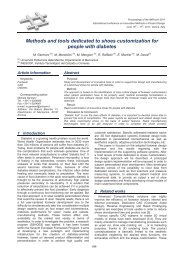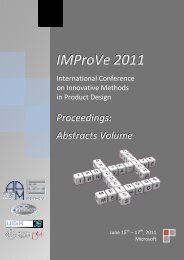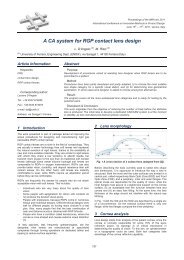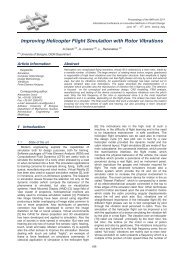IMProVe 2011 - Proceedings
IMProVe 2011 - Proceedings
IMProVe 2011 - Proceedings
You also want an ePaper? Increase the reach of your titles
YUMPU automatically turns print PDFs into web optimized ePapers that Google loves.
Engineering Methods in Medicine<br />
Structural analysis<br />
of a posterior stability total knee joint replacement<br />
T. Ingrassia (a), L. Nalbone (b), V. Nigrelli (a), D. Tumino (c), V. Ricotta (a)<br />
(a) Università degli Studi di Palermo,<br />
Dipartimento di Ingegneria Chimica, Gestionale, Informatica e Meccanica<br />
(b) Azienda Ospedaliera Universitaria Policlinico Paolo Giaccone di Palermo,<br />
Ambulatorio di Ortopedia e Traumatologia<br />
(c) Università degli Studi di Enna Kore – Facoltà di Ingegneria ed Architettura<br />
Abstract:<br />
Aim of this work is to compare two different total knee prostheses that differ in the shape<br />
of the Polyethylene (PE) insert, trying to optimize the shape of the best one, in order to<br />
reduce the stress peaks.<br />
The study procedure has been divided into the following steps. First step has been the<br />
three-dimensional shape acquisition of the two prostheses by means of a COMET5 3D<br />
scanner. The morphology of two prototypes of the prostheses has been acquired by<br />
elaborating multiple Moirè fringe pattern projected on their surfaces. Second step<br />
consisted of the manipulation of these data in a CAD module, that is the interpolation of<br />
raw data into parametric surfaces, reducing singularities due to the typical scattering of<br />
the acquiring system. Third step has been the setting up of FEM simulations to evaluate<br />
the prostheses behaviour under typical loading conditions. The CAD model of the<br />
prostheses has been meshed into solid finite elements.<br />
Different flexion angles configurations have been analysed, the load being applied along<br />
the femoral axis. FEM analyses have returned stress fields in the PE insert and, in<br />
particular, in the stabilizing cam which function is to avoid dislocation.<br />
Last step has been the integrated use of CAD-FEM to modify the shape of the stabilizing<br />
cam of the best prosthesis, in order to reduce the stress peaks in the original prosthesis<br />
without compromising the kinematics of the joint. Good results have been obtained both<br />
in terms of stress and contact pressure peaks reduction.<br />
Keywords: Total knee replacement, FEM simulation, Contact analysis.<br />
Corresponding Author: Davide Tumino<br />
Tel: (+39) 0935536491<br />
Fax.: (+39) 091484334<br />
e-mail: davide.tumino@unikore.it<br />
Address: Facoltà di Ingegneria e Architettura, Cittadella Universitaria, 94100, Enna.<br />
June 15 th – 17 th , <strong>2011</strong>, Venice, Italy<br />
116<br />
<strong>IMProVe</strong> <strong>2011</strong> - <strong>Proceedings</strong>










